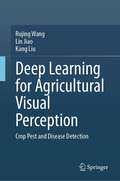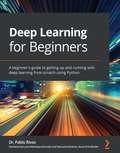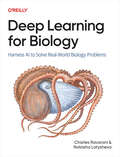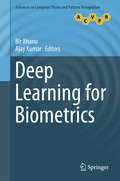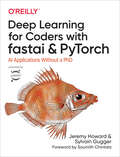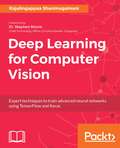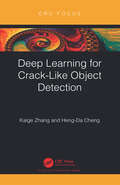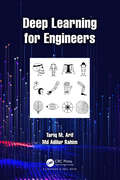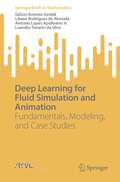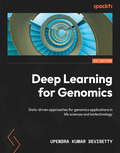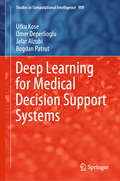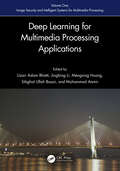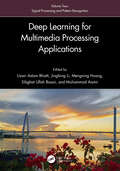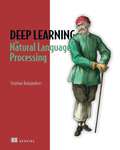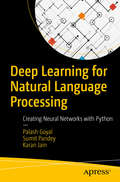- Table View
- List View
Deep Learning for Agricultural Visual Perception: Crop Pest and Disease Detection
by Kang Liu Rujing Wang Lin JiaoThis monograph provides a detailed and systematic introduction to the application of deep learning technology in the intelligent monitoring of crop diseases and pests. Taking 24 types of crop pests, wheat aphids, and wheat diseases with complex backgrounds as examples, a large-scale crop pest and disease dataset was constructed to provide necessary data support for the deep learning module. Various schemes for identifying and detecting large-scale crop diseases and pests based on deep convolutional neural network technology have also been proposed. This book can be used as a reference for teachers and students majoring in agriculture, computer science, artificial intelligence, intelligent science and technology, and other related fields in higher education institutions. It can also be used as a reference book for researchers in fields such as image processing technology, intelligent manufacturing, and high-tech applications.
Deep Learning for Beginners: A beginner's guide to getting up and running with deep learning from scratch using Python
by Dr. Pablo Rivas Laura MontoyaImplementing supervised, unsupervised, and generative deep learning (DL) models using Keras and Dopamine over TensorFlow. Key Features Understand the fundamental machine learning concepts useful in deep learning Learn the underlying mathematical concepts as you implement deep learning models from scratch Explore easy-to-understand examples and use cases that will help you build a solid foundation in DL Book Description With information on the web exponentially increasing, it has become more difficult than ever to navigate through everything to find reliable content that will help you get started with deep learning. This book is designed to help you if you're a beginner looking to work on deep learning and build deep learning models from scratch, and already have the basic mathematical and programming knowledge required to get started. The book begins with a basic overview of machine learning, guiding you through setting up popular Python frameworks. You will also understand how to prepare data by cleaning and preprocessing it for deep learning, and gradually go on to explore neural networks. A dedicated section will give you insights into the working of neural networks by helping you get hands-on with training single and multiple layers of neurons. Later, you will cover popular neural network architectures such as CNNs, RNNs, AEs, VAEs, and GANs with the help of simple examples, and you will even build models from scratch. At the end of each chapter, you will find a question and answer section to help you test what you've learned through the course of the book. By the end of this book, you'll be well-versed with deep learning concepts and have the knowledge you need to use specific algorithms with various tools for different tasks. What you will learn Implement RNNs and Long short-term memory for image classification and Natural Language Processing tasks Explore the role of CNNs in computer vision and signal processing Understand the ethical implications of deep learning modeling Understand the mathematical terminology associated with deep learning Code a GAN and a VAE to generate images from a learned latent space Implement visualization techniques to compare AEs and VAEs Who this book is for This book is for aspiring data scientists and deep learning engineers who want to get started with the fundamentals of deep learning and neural networks. Although no prior knowledge of deep learning or machine learning is required, familiarity with linear algebra and Python programming is necessary to get started.
Deep Learning for Biology: Harness AI to Solve Real-World Biology Problems
by Charles Ravarani Natasha LatyshevaBridge the gap between modern machine learning and real-world biology with this practical, project-driven guide. Whether your background is in biology, software engineering, or data science, Deep Learning for Biology gives you the tools to develop deep learning models for tackling a wide range of biological problems. Authors Charles Ravarani and Natasha Latysheva guide you through hands-on projects applying deep learning to domains like DNA, proteins, biological networks, medical images, and microscopy. Each chapter is a self-contained mini-project, with step-by-step explanations that teach you how to train and interpret deep learning models using real biological data. Build models for real-world biological problems such as gene regulation, protein function prediction, drug interactions, and cancer detection Apply architectures like convolutional neural networks, transformers, graph neural networks, and autoencoders Use Python and interactive notebooks for hands-on learning Build problem-solving intuition that generalizes beyond biology Whether you’re exploring new methods, transitioning into computational biology, or looking to make sense of machine learning in your field, this book offers a clear and approachable path forward.
Deep Learning for Biomedical Applications (Artificial Intelligence (AI): Elementary to Advanced Practices)
by D. Jude Hemanth Utku Kose Omer DeperliogluThis book is a detailed reference on biomedical applications using Deep Learning. Because Deep Learning is an important actor shaping the future of Artificial Intelligence, its specific and innovative solutions for both medical and biomedical are very critical. This book provides a recent view of research works on essential, and advanced topics. The book offers detailed information on the application of Deep Learning for solving biomedical problems. It focuses on different types of data (i.e. raw data, signal-time series, medical images) to enable readers to understand the effectiveness and the potential. It includes topics such as disease diagnosis, image processing perspectives, and even genomics. It takes the reader through different sides of Deep Learning oriented solutions. The specific and innovative solutions covered in this book for both medical and biomedical applications are critical to scientists, researchers, practitioners, professionals, and educations who are working in the context of the topics.
Deep Learning for Biomedical Data Analysis: Techniques, Approaches, and Applications
by Mourad ElloumiThis book is the first overview on Deep Learning (DL) for biomedical data analysis. It surveys the most recent techniques and approaches in this field, with both a broad coverage and enough depth to be of practical use to working professionals. This book offers enough fundamental and technical information on these techniques, approaches and the related problems without overcrowding the reader's head. It presents the results of the latest investigations in the field of DL for biomedical data analysis. The techniques and approaches presented in this book deal with the most important and/or the newest topics encountered in this field. They combine fundamental theory of Artificial Intelligence (AI), Machine Learning (ML) and DL with practical applications in Biology and Medicine. Certainly, the list of topics covered in this book is not exhaustive but these topics will shed light on the implications of the presented techniques and approaches on other topics in biomedical data analysis. The book finds a balance between theoretical and practical coverage of a wide range of issues in the field of biomedical data analysis, thanks to DL. The few published books on DL for biomedical data analysis either focus on specific topics or lack technical depth. The chapters presented in this book were selected for quality and relevance. The book also presents experiments that provide qualitative and quantitative overviews in the field of biomedical data analysis. The reader will require some familiarity with AI, ML and DL and will learn about techniques and approaches that deal with the most important and/or the newest topics encountered in the field of DL for biomedical data analysis. He/she will discover both the fundamentals behind DL techniques and approaches, and their applications on biomedical data. This book can also serve as a reference book for graduate courses in Bioinformatics, AI, ML and DL. The book aims not only at professional researchers and practitioners but also graduate students, senior undergraduate students and young researchers. This book will certainly show the way to new techniques and approaches to make new discoveries.
Deep Learning for Biometrics (Advances in Computer Vision and Pattern Recognition)
by Bir Bhanu Ajay KumarThis timely text/reference presents a broad overview of advanced deep learning architectures for learning effective feature representation for perceptual and biometrics-related tasks. The text offers a showcase of cutting-edge research on the use of convolutional neural networks (CNN) in face, iris, fingerprint, and vascular biometric systems, in addition to surveillance systems that use soft biometrics. Issues of biometrics security are also examined. Topics and features: addresses the application of deep learning to enhance the performance of biometrics identification across a wide range of different biometrics modalities; revisits deep learning for face biometrics, offering insights from neuroimaging, and provides comparison with popular CNN-based architectures for face recognition; examines deep learning for state-of-the-art latent fingerprint and finger-vein recognition, as well as iris recognition; discusses deep learning for soft biometrics, including approaches for gesture-based identification, gender classification, and tattoo recognition; investigates deep learning for biometrics security, covering biometrics template protection methods, and liveness detection to protect against fake biometrics samples; presents contributions from a global selection of pre-eminent experts in the field representing academia, industry and government laboratories. Providing both an accessible introduction to the practical applications of deep learning in biometrics, and a comprehensive coverage of the entire spectrum of biometric modalities, this authoritative volume will be of great interest to all researchers, practitioners and students involved in related areas of computer vision, pattern recognition and machine learning.
Deep Learning for Cancer Diagnosis (Studies in Computational Intelligence #908)
by Utku Kose Jafar AlzubiThis book explores various applications of deep learning to the diagnosis of cancer,while also outlining the future face of deep learning-assisted cancer diagnostics. As is commonly known, artificial intelligence has paved the way for countless new solutions in the field of medicine. In this context, deep learning is a recent and remarkable sub-field, which can effectively cope with huge amounts of data and deliver more accurate results. As a vital research area, medical diagnosis is among those in which deep learning-oriented solutions are often employed.Accordingly, the objective of this book is to highlight recent advanced applications of deep learning for diagnosing different types of cancer. The target audience includes scientists, experts, MSc and PhD students, postdocs, and anyone interested in the subjects discussed. The book can be used as a reference work to support courses on artificial intelligence, medical and biomedicaleducation.
Deep Learning for Coders with fastai and PyTorch: Ai Applications Without A Phd
by Jeremy Howard Sylvain GuggerDeep learning is often viewed as the exclusive domain of math PhDs and big tech companies. But as this hands-on guide demonstrates, programmers comfortable with Python can achieve impressive results in deep learning with little math background, small amounts of data, and minimal code. How? With fastai, the first library to provide a consistent interface to the most frequently used deep learning applications.Authors Jeremy Howard and Sylvain Gugger, the creators of fastai, show you how to train a model on a wide range of tasks using fastai and PyTorch. You’ll also dive progressively further into deep learning theory to gain a complete understanding of the algorithms behind the scenes.Train models in computer vision, natural language processing, tabular data, and collaborative filteringLearn the latest deep learning techniques that matter most in practiceImprove accuracy, speed, and reliability by understanding how deep learning models workDiscover how to turn your models into web applicationsImplement deep learning algorithms from scratchConsider the ethical implications of your workGain insight from the foreword by PyTorch cofounder, Soumith Chintala
Deep Learning for Computational Problems in Hardware Security: Modeling Attacks on Strong Physically Unclonable Function Circuits (Studies in Computational Intelligence #1052)
by Rajat Subhra Chakraborty Pranesh SantikellurThe book discusses a broad overview of traditional machine learning methods and state-of-the-art deep learning practices for hardware security applications, in particular the techniques of launching potent "modeling attacks" on Physically Unclonable Function (PUF) circuits, which are promising hardware security primitives. The volume is self-contained and includes a comprehensive background on PUF circuits, and the necessary mathematical foundation of traditional and advanced machine learning techniques such as support vector machines, logistic regression, neural networks, and deep learning. This book can be used as a self-learning resource for researchers and practitioners of hardware security, and will also be suitable for graduate-level courses on hardware security and application of machine learning in hardware security. A stand-out feature of the book is the availability of reference software code and datasets to replicate the experiments described in the book.
Deep Learning for Computer Vision: Expert techniques to train advanced neural networks using TensorFlow and Keras
by Rajalingappaa Shanmugamani Abdul Ghani Abdul Rahman Stephen Maurice Moore Nishanth KogantiLearn how to model and train advanced neural networks to implement a variety of Computer Vision tasks Key Features Train different kinds of deep learning model from scratch to solve specific problems in Computer Vision Combine the power of Python, Keras, and TensorFlow to build deep learning models for object detection, image classification, similarity learning, image captioning, and more Includes tips on optimizing and improving the performance of your models under various constraints Book Description Deep learning has shown its power in several application areas of Artificial Intelligence, especially in Computer Vision. Computer Vision is the science of understanding and manipulating images, and finds enormous applications in the areas of robotics, automation, and so on. This book will also show you, with practical examples, how to develop Computer Vision applications by leveraging the power of deep learning. In this book, you will learn different techniques related to object classification, object detection, image segmentation, captioning, image generation, face analysis, and more. You will also explore their applications using popular Python libraries such as TensorFlow and Keras. This book will help you master state-of-the-art, deep learning algorithms and their implementation. What you will learn Set up an environment for deep learning with Python, TensorFlow, and Keras Define and train a model for image and video classification Use features from a pre-trained Convolutional Neural Network model for image retrieval Understand and implement object detection using the real-world Pedestrian Detection scenario Learn about various problems in image captioning and how to overcome them by training images and text together Implement similarity matching and train a model for face recognition Understand the concept of generative models and use them for image generation Deploy your deep learning models and optimize them for high performance Who this book is for This book is targeted at data scientists and Computer Vision practitioners who wish to apply the concepts of Deep Learning to overcome any problem related to Computer Vision. A basic knowledge of programming in Python—and some understanding of machine learning concepts—is required to get the best out of this book.
Deep Learning for Crack-Like Object Detection
by Kaige Zhang Heng-Da ChengComputer vision-based crack-like object detection has many useful applications, such as inspecting/monitoring pavement surface, underground pipeline, bridge cracks, railway tracks etc. However, in most contexts, cracks appear as thin, irregular long-narrow objects, and often are buried in complex, textured background with high diversity which make the crack detection very challenging. During the past a few years, deep learning technique has achieved great success and has been utilized for solving a variety of object detection problems. This book discusses crack-like object detection problem comprehensively. It starts by discussing traditional image processing approaches for solving this problem, and then introduces deep learning-based methods. It provides a detailed review of object detection problems and focuses on the most challenging problem, crack-like object detection, to dig deep into the deep learning method. It includes examples of real-world problems, which are easy to understand and could be a good tutorial for introducing computer vision and machine learning.
Deep Learning for Engineers
by Tariq M. Arif Md Adilur RahimDeep Learning for Engineers introduces the fundamental principles of deep learning along with an explanation of the basic elements required for understanding and applying deep learning models. As a comprehensive guideline for applying deep learning models in practical settings, this book features an easy-to-understand coding structure using Python and PyTorch with an in-depth explanation of four typical deep learning case studies on image classification, object detection, semantic segmentation, and image captioning. The fundamentals of convolutional neural network (CNN) and recurrent neural network (RNN) architectures and their practical implementations in science and engineering are also discussed. This book includes exercise problems for all case studies focusing on various fine-tuning approaches in deep learning. Science and engineering students at both undergraduate and graduate levels, academic researchers, and industry professionals will find the contents useful.
Deep Learning for Finance: Creating Machine & Deep Learning Models for Trading in Python
by Sofien KaabarDeep learning is rapidly gaining momentum in the world of finance and trading. But for many professional traders, this sophisticated field has a reputation for being complex and difficult. This hands-on guide teaches you how to develop a deep learning trading model from scratch using Python, and it also helps you create and backtest trading algorithms based on machine learning and reinforcement learning.Sofien Kaabar—financial author, trading consultant, and institutional market strategist—introduces deep learning strategies that combine technical and quantitative analyses. By fusing deep learning concepts with technical analysis, this unique book presents outside-the-box ideas in the world of financial trading. This A-Z guide also includes a full introduction to technical analysis, evaluating machine learning algorithms, and algorithm optimization.Understand and create machine learning and deep learning modelsExplore the details behind reinforcement learning and see how it's used in time seriesUnderstand how to interpret performance evaluation metricsExamine technical analysis and learn how it works in financial marketsCreate technical indicators in Python and combine them with ML models for optimizationEvaluate the models' profitability and predictability to understand their limitations and potential
Deep Learning for Fluid Simulation and Animation: Fundamentals, Modeling, and Case Studies (SpringerBriefs in Mathematics)
by Gilson Antonio Giraldi Liliane Rodrigues Almeida Antonio Lopes Apolinário Jr. Leandro Tavares SilvaThis book is an introduction to the use of machine learning and data-driven approaches in fluid simulation and animation, as an alternative to traditional modeling techniques based on partial differential equations and numerical methods – and at a lower computational cost.This work starts with a brief review of computability theory, aimed to convince the reader – more specifically, researchers of more traditional areas of mathematical modeling – about the power of neural computing in fluid animations. In these initial chapters, fluid modeling through Navier-Stokes equations and numerical methods are also discussed.The following chapters explore the advantages of the neural networks approach and show the building blocks of neural networks for fluid simulation. They cover aspects related to training data, data augmentation, and testing. The volume completes with two case studies, one involving Lagrangian simulation of fluids using convolutional neural networks and the other using Generative Adversarial Networks (GANs) approaches.
Deep Learning for Genomics: Data-driven approaches for genomics applications in life sciences and biotechnology
by Upendra Kumar DevisettyLearn concepts, methodologies, and applications of deep learning for building predictive models from complex genomics data sets to overcome challenges in the life sciences and biotechnology industriesKey FeaturesApply deep learning algorithms to solve real-world problems in the field of genomicsExtract biological insights from deep learning models built from genomic datasetsTrain, tune, evaluate, deploy, and monitor deep learning models for enabling predictions in genomicsBook DescriptionDeep learning has shown remarkable promise in the field of genomics; however, there is a lack of a skilled deep learning workforce in this discipline. This book will help researchers and data scientists to stand out from the rest of the crowd and solve real-world problems in genomics by developing the necessary skill set. Starting with an introduction to the essential concepts, this book highlights the power of deep learning in handling big data in genomics. First, you'll learn about conventional genomics analysis, then transition to state-of-the-art machine learning-based genomics applications, and finally dive into deep learning approaches for genomics. The book covers all of the important deep learning algorithms commonly used by the research community and goes into the details of what they are, how they work, and their practical applications in genomics. The book dedicates an entire section to operationalizing deep learning models, which will provide the necessary hands-on tutorials for researchers and any deep learning practitioners to build, tune, interpret, deploy, evaluate, and monitor deep learning models from genomics big data sets. By the end of this book, you'll have learned about the challenges, best practices, and pitfalls of deep learning for genomics.What you will learnDiscover the machine learning applications for genomicsExplore deep learning concepts and methodologies for genomics applicationsUnderstand supervised deep learning algorithms for genomics applicationsGet to grips with unsupervised deep learning with autoencodersImprove deep learning models using generative modelsOperationalize deep learning models from genomics datasetsVisualize and interpret deep learning modelsUnderstand deep learning challenges, pitfalls, and best practicesWho this book is forThis deep learning book is for machine learning engineers, data scientists, and academicians practicing in the field of genomics. It assumes that readers have intermediate Python programming knowledge, basic knowledge of Python libraries such as NumPy and Pandas to manipulate and parse data, Matplotlib, and Seaborn for visualizing data, along with a base in genomics and genomic analysis concepts.
Deep Learning for Human Activity Recognition: Second International Workshop, DL-HAR 2020, Held in Conjunction with IJCAI-PRICAI 2020, Kyoto, Japan, January 8, 2021, Proceedings (Communications in Computer and Information Science #1370)
by Xiaoli Li Min Wu Zhenghua Chen Le ZhangThis book constitutes refereed proceedings of the Second International Workshop on Deep Learning for Human Activity Recognition, DL-HAR 2020, held in conjunction with IJCAI-PRICAI 2020, in Kyoto, Japan, in January 2021. Due to the COVID-19 pandemic the workshop was postponed to the year 2021 and held in a virtual format. The 10 presented papers were thorougly reviewed and included in the volume. They present recent research on applications of human activity recognition for various areas such as healthcare services, smart home applications, and more.
Deep Learning for Hydrometeorology and Environmental Science (Water Science and Technology Library #99)
by Vijay P. Singh Taesam Lee Kyung Hwa ChoThis book provides a step-by-step methodology and derivation of deep learning algorithms as Long Short-Term Memory (LSTM) and Convolution Neural Network (CNN), especially for estimating parameters, with back-propagation as well as examples with real datasets of hydrometeorology (e.g. streamflow and temperature) and environmental science (e.g. water quality). Deep learning is known as part of machine learning methodology based on the artificial neural network. Increasing data availability and computing power enhance applications of deep learning to hydrometeorological and environmental fields. However, books that specifically focus on applications to these fields are limited.Most of deep learning books demonstrate theoretical backgrounds and mathematics. However, examples with real data and step-by-step explanations to understand the algorithms in hydrometeorology and environmental science are very rare. This book focuses on the explanation of deep learning techniques and their applications to hydrometeorological and environmental studies with real hydrological and environmental data. This book covers the major deep learning algorithms as Long Short-Term Memory (LSTM) and Convolution Neural Network (CNN) as well as the conventional artificial neural network model.
Deep Learning for Hyperspectral Image Analysis and Classification (Engineering Applications of Computational Methods #5)
by Linmi Tao Atif MugheesThis book focuses on deep learning-based methods for hyperspectral image (HSI) analysis. Unsupervised spectral-spatial adaptive band-noise factor-based formulation is devised for HSI noise detection and band categorization. The method to characterize the bands along with the noise estimation of HSIs will benefit subsequent remote sensing techniques significantly. This book develops on two fronts: On the one hand, it is aimed at domain professionals who want to have an updated overview of how hyperspectral acquisition techniques can combine with deep learning architectures to solve specific tasks in different application fields. On the other hand, the authors want to target the machine learning and computer vision experts by giving them a picture of how deep learning technologies are applied to hyperspectral data from a multidisciplinary perspective. The presence of these two viewpoints and the inclusion of application fields of remote sensing by deep learning are the original contributions of this review, which also highlights some potentialities and critical issues related to the observed development trends.
Deep Learning for Internet of Things Infrastructure
by Al-Sakib Khan Pathan Mamoun Alazab Uttam Ghosh Ali Kashif BashirThis book promotes and facilitates exchanges of research knowledge and findings across different disciplines on the design and investigation of deep learning (DL)–based data analytics of IoT (Internet of Things) infrastructures. Deep Learning for Internet of Things Infrastructure addresses emerging trends and issues on IoT systems and services across various application domains. The book investigates the challenges posed by the implementation of deep learning on IoT networking models and services. It provides fundamental theory, model, and methodology in interpreting, aggregating, processing, and analyzing data for intelligent DL-enabled IoT. The book also explores new functions and technologies to provide adaptive services and intelligent applications for different end users. FEATURES Promotes and facilitates exchanges of research knowledge and findings across different disciplines on the design and investigation of DL-based data analytics of IoT infrastructures Addresses emerging trends and issues on IoT systems and services across various application domains Investigates the challenges posed by the implementation of deep learning on IoT networking models and services Provides fundamental theory, model, and methodology in interpreting, aggregating, processing, and analyzing data for intelligent DL-enabled IoT Explores new functions and technologies to provide adaptive services and intelligent applications for different end users Uttam Ghosh is an Assistant Professor in the Department of Electrical Engineering and Computer Science, Vanderbilt University, Nashville, Tennessee, USA. Mamoun Alazab is an Associate Professor in the College of Engineering, IT and Environment at Charles Darwin University, Australia. Ali Kashif Bashir is a Senior Lecturer/Associate Professor and Program Leader of BSc (H) Computer Forensics and Security at the Department of Computing and Mathematics, Manchester Metropolitan University, United Kingdom. Al-Sakib Khan Pathan is an Adjunct Professor of Computer Science and Engineering at the Independent University, Bangladesh.
Deep Learning for Medical Decision Support Systems (Studies in Computational Intelligence #909)
by Bogdan Patrut Utku Kose Omer Deperlioglu Jafar AlzubiThis book explores various applications of deep learning-oriented diagnosis leading to decision support, while also outlining the future face of medical decision support systems. Artificial intelligence has now become a ubiquitous aspect of modern life, and especially machine learning enjoysgreat popularity, since it offers techniques that are capable of learning from samples to solve newly encountered cases. Today, a recent form of machine learning, deep learning, is being widely used with large, complex quantities of data, because today’s problems require detailed analyses of more data. This is critical, especially in fields such as medicine. Accordingly, the objective of this book is to provide the essentials of and highlight recent applications of deep learning architectures for medical decision support systems. The target audience includes scientists, experts, MSc and PhD students, postdocs, and any readers interested in the subjectsdiscussed. The book canbe used as a reference work to support courses on artificial intelligence, machine/deep learning, medical and biomedicaleducation.
Deep Learning for Multimedia Processing Applications: Volume One: Image Security and Intelligent Systems for Multimedia Processing
by Mengxing Huang Muhammad Aamir Uzair Aslam Bhatti Jingbing Li Sibghat Ullah BazaiDeep Learning for Multimedia Processing Applications is a comprehensive guide that explores the revolutionary impact of deep learning techniques in the field of multimedia processing. Written for a wide range of readers, from students to professionals, this book offers a concise and accessible overview of the application of deep learning in various multimedia domains, including image processing, video analysis, audio recognition, and natural language processing. Divided into two volumes, Volume One begins by introducing the fundamental concepts of deep learning, providing readers with a solid foundation to understand its relevance in multimedia processing. Readers will discover how deep learning techniques enable accurate and efficient image recognition, object detection, semantic segmentation, and image synthesis. The book also covers video analysis techniques, including action recognition, video captioning, and video generation, highlighting the role of deep learning in extracting meaningful information from videos. Furthermore, the book explores audio processing tasks such as speech recognition, music classification, and sound event detection using deep learning models. It demonstrates how deep learning algorithms can effectively process audio data, opening up new possibilities in multimedia applications. Lastly, the book explores the integration of deep learning with natural language processing techniques, enabling systems to understand, generate, and interpret textual information in multimedia contexts. Throughout the book, practical examples, code snippets, and real-world case studies are provided to help readers gain hands-on experience in implementing deep learning solutions for multimedia processing. Deep Learning for Multimedia Processing Applications is an essential resource for anyone interested in harnessing the power of deep learning to unlock the vast potential of multimedia data.
Deep Learning for Multimedia Processing Applications: Volume Two: Signal Processing and Pattern Recognition
by Mengxing Huang Muhammad Aamir Uzair Aslam Bhatti Jingbing Li Sibghat Ullah BazaiDeep Learning for Multimedia Processing Applications is a comprehensive guide that explores the revolutionary impact of deep learning techniques in the field of multimedia processing. Written for a wide range of readers, from students to professionals, this book offers a concise and accessible overview of the application of deep learning in various multimedia domains, including image processing, video analysis, audio recognition, and natural language processing. Divided into two volumes, Volume Two delves into advanced topics such as convolutional neural networks (CNNs), recurrent neural networks (RNNs), and generative adversarial networks (GANs), explaining their unique capabilities in multimedia tasks. Readers will discover how deep learning techniques enable accurate and efficient image recognition, object detection, semantic segmentation, and image synthesis. The book also covers video analysis techniques, including action recognition, video captioning, and video generation, highlighting the role of deep learning in extracting meaningful information from videos. Furthermore, the book explores audio processing tasks such as speech recognition, music classification, and sound event detection using deep learning models. It demonstrates how deep learning algorithms can effectively process audio data, opening up new possibilities in multimedia applications. Lastly, the book explores the integration of deep learning with natural language processing techniques, enabling systems to understand, generate, and interpret textual information in multimedia contexts. Throughout the book, practical examples, code snippets, and real-world case studies are provided to help readers gain hands-on experience in implementing deep learning solutions for multimedia processing. Deep Learning for Multimedia Processing Applications is an essential resource for anyone interested in harnessing the power of deep learning to unlock the vast potential of multimedia data.
Deep Learning for NLP and Speech Recognition
by Uday Kamath John Liu James WhitakerThis textbook explains Deep Learning Architecture, with applications to various NLP Tasks, including Document Classification, Machine Translation, Language Modeling, and Speech Recognition. With the widespread adoption of deep learning, natural language processing (NLP),and speech applications in many areas (including Finance, Healthcare, and Government) there is a growing need for one comprehensive resource that maps deep learning techniques to NLP and speech and provides insights into using the tools and libraries for real-world applications. Deep Learning for NLP and Speech Recognition explains recent deep learning methods applicable to NLP and speech, provides state-of-the-art approaches, and offers real-world case studies with code to provide hands-on experience. Many books focus on deep learning theory or deep learning for NLP-specific tasks while others are cookbooks for tools and libraries, but the constant flux of new algorithms, tools, frameworks, and libraries in a rapidly evolving landscape means that there are few available texts that offer the material in this book. The book is organized into three parts, aligning to different groups of readers and their expertise. The three parts are: Machine Learning, NLP, and Speech Introduction The first part has three chapters that introduce readers to the fields of NLP, speech recognition, deep learning and machine learning with basic theory and hands-on case studies using Python-based tools and libraries. Deep Learning Basics The five chapters in the second part introduce deep learning and various topics that are crucial for speech and text processing, including word embeddings, convolutional neural networks, recurrent neural networks and speech recognition basics. Theory, practical tips, state-of-the-art methods, experimentations and analysis in using the methods discussed in theory on real-world tasks. Advanced Deep Learning Techniques for Text and Speech The third part has five chapters that discuss the latest and cutting-edge research in the areas of deep learning that intersect with NLP and speech. Topics including attention mechanisms, memory augmented networks, transfer learning, multi-task learning, domain adaptation, reinforcement learning, and end-to-end deep learning for speech recognition are covered using case studies.
Deep Learning for Natural Language Processing
by Stephan RaaijmakersExplore the most challenging issues of natural language processing, and learn how to solve them with cutting-edge deep learning!Inside Deep Learning for Natural Language Processing you&’ll find a wealth of NLP insights, including: An overview of NLP and deep learning One-hot text representations Word embeddings Models for textual similarity Sequential NLP Semantic role labeling Deep memory-based NLP Linguistic structure Hyperparameters for deep NLP Deep learning has advanced natural language processing to exciting new levels and powerful new applications! For the first time, computer systems can achieve "human" levels of summarizing, making connections, and other tasks that require comprehension and context. Deep Learning for Natural Language Processing reveals the groundbreaking techniques that make these innovations possible. Stephan Raaijmakers distills his extensive knowledge into useful best practices, real-world applications, and the inner workings of top NLP algorithms. About the technology Deep learning has transformed the field of natural language processing. Neural networks recognize not just words and phrases, but also patterns. Models infer meaning from context, and determine emotional tone. Powerful deep learning-based NLP models open up a goldmine of potential uses. About the book Deep Learning for Natural Language Processing teaches you how to create advanced NLP applications using Python and the Keras deep learning library. You&’ll learn to use state-of the-art tools and techniques including BERT and XLNET, multitask learning, and deep memory-based NLP. Fascinating examples give you hands-on experience with a variety of real world NLP applications. Plus, the detailed code discussions show you exactly how to adapt each example to your own uses! What's inside Improve question answering with sequential NLP Boost performance with linguistic multitask learning Accurately interpret linguistic structure Master multiple word embedding techniques About the reader For readers with intermediate Python skills and a general knowledge of NLP. No experience with deep learning is required. About the author Stephan Raaijmakers is professor of Communicative AI at Leiden University and a senior scientist at The Netherlands Organization for Applied Scientific Research (TNO). Table of Contents PART 1 INTRODUCTION 1 Deep learning for NLP 2 Deep learning and language: The basics 3 Text embeddings PART 2 DEEP NLP 4 Textual similarity 5 Sequential NLP 6 Episodic memory for NLP PART 3 ADVANCED TOPICS 7 Attention 8 Multitask learning 9 Transformers 10 Applications of Transformers: Hands-on with BERT
Deep Learning for Natural Language Processing: Creating Neural Networks with Python
by Palash Goyal Sumit Pandey Karan JainDiscover the concepts of deep learning used for natural language processing (NLP), with full-fledged examples of neural network models such as recurrent neural networks, long short-term memory networks, and sequence-2-sequence models.You’ll start by covering the mathematical prerequisites and the fundamentals of deep learning and NLP with practical examples. The first three chapters of the book cover the basics of NLP, starting with word-vector representation before moving onto advanced algorithms. The final chapters focus entirely on implementation, and deal with sophisticated architectures such as RNN, LSTM, and Seq2seq, using Python tools: TensorFlow, and Keras. Deep Learning for Natural Language Processing follows a progressive approach and combines all the knowledge you have gained to build a question-answer chatbot system.This book is a good starting point for people who want to get started in deep learning for NLP. All the code presented in the book will be available in the form of IPython notebooks and scripts, which allow you to try out the examples and extend them in interesting ways.What You Will LearnGain the fundamentals of deep learning and its mathematical prerequisitesDiscover deep learning frameworks in Python Develop a chatbot Implement a research paper on sentiment classificationWho This Book Is ForSoftware developers who are curious to try out deep learning with NLP.
